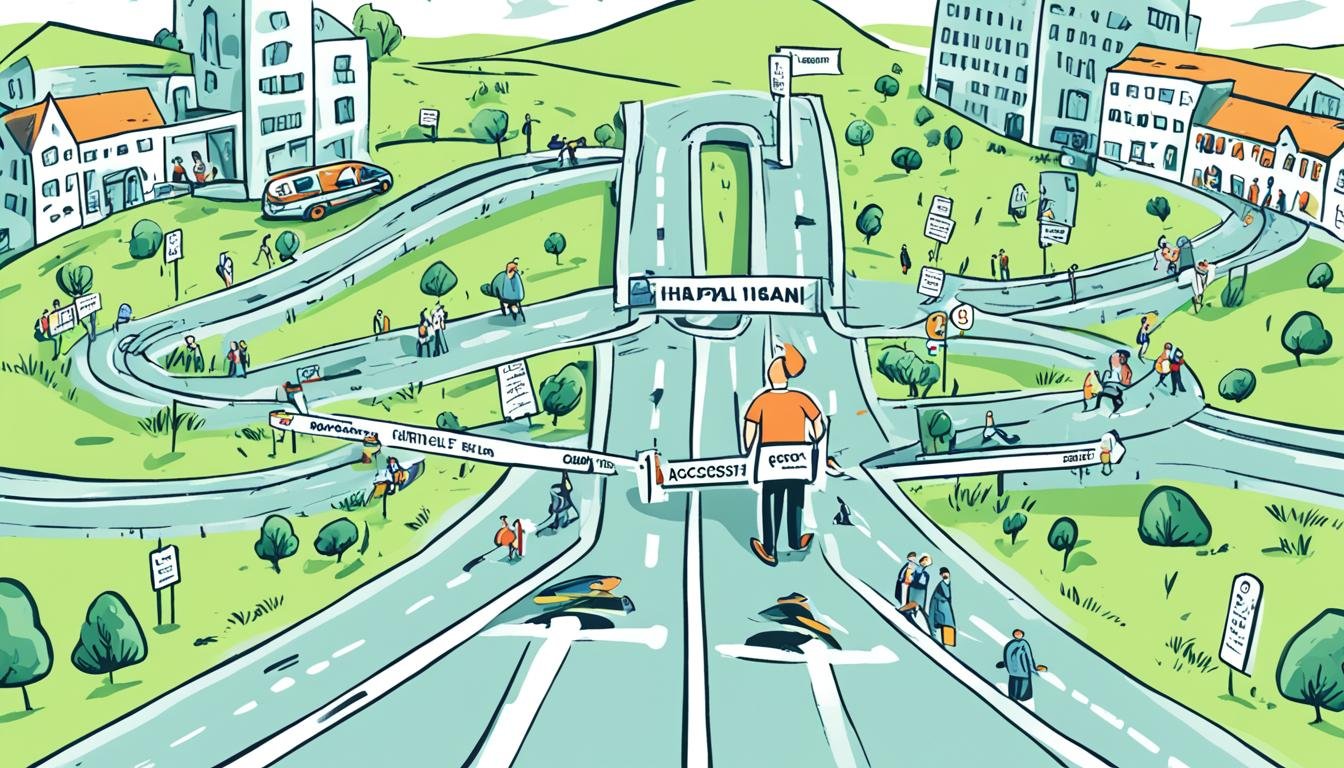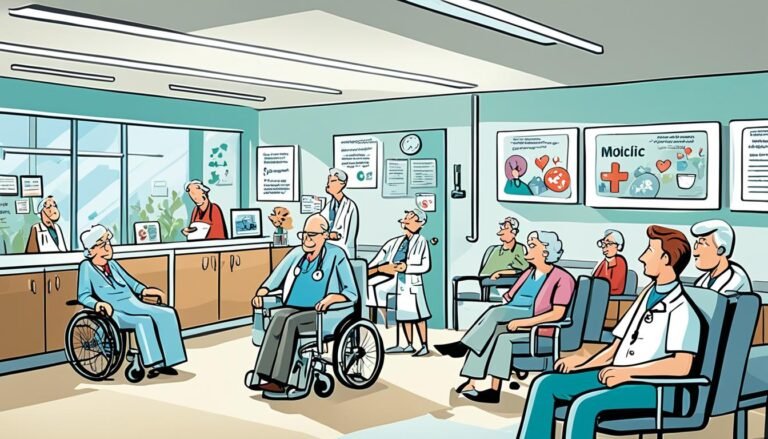Access to Healthcare: Overcoming Barriers in Ireland
Did you know that many people in Ireland face challenges getting to healthcare because of cost? This shows how hard it is to get healthcare in Ireland. It’s important to understand these issues to make sure everyone can get the care they need.
Ireland’s healthcare budget went up to €23.4 billion in 2023. This shows the government is serious about fixing these problems. But, even with new plans like Sláintecare, getting healthcare fairly is still tough. Rural areas and economic issues make it hard for some to get healthcare.
Efforts like free GP care and reforms are trying to help everyone get the health services they need. But, making healthcare better for everyone takes a lot of work from everyone involved.
Key Takeaways
- Private health costs are a big problem for getting healthcare in Ireland.
- The healthcare budget in Ireland went up to €23.4 billion in 2023, showing the government’s effort to improve access.
- Even with progress, location and money issues still make healthcare hard to get in Ireland.
- Reforms like Sláintecare are working towards universal healthcare and fixing unfairness.
- Everyone’s ongoing efforts are key to fixing healthcare issues in Ireland.
Introduction to Healthcare Accessibility in Ireland
The Irish health system includes both public and private services. It is managed by the Department of Health and the Health Service Executive (HSE). There’s a big push for healthcare equity and better services across Ireland.
Overview of the Current Healthcare System
Ireland’s healthcare system offers both public and private options. Public health spending fell from €15.4 billion in 2008 to €13.6 billion in 2013. This was due to cost cuts and productivity gains.
Despite high unemployment and income drops, Ireland keeps working on improving healthcare. Unemployment hit nearly 14% by late 2012, and incomes fell by over 12% from 2008 to 2012.
Importance of Accessible Healthcare for All
With economic challenges, making healthcare accessible is key. Projects like Sláintecare aim for a health system that everyone can use. It’s not just about having services; it’s about making sure everyone can get the care they need, no matter their wealth.
This approach helps improve patient experiences, lowers healthcare costs, and leads to better health outcomes. The 2023 healthcare budget shows this focus, with €23.4 billion set aside for these goals.
Healthcare services in Ireland are changing to be more accessible and fair. These changes aim to fix past issues and create a health system that includes everyone.
Economic Barriers to Healthcare Accessibility
The healthcare system in Ireland faces big challenges due to economic barriers. These issues show how funding, affordability, and accessibility are linked.
Impact of Economic Crisis on Healthcare Funding
The economic crisis hit healthcare funding hard in Ireland. Austerity led to a 9% cut in public health spending by 2008. This meant cost-saving reforms in areas like pharmaceuticals and staff to keep care quality high.
At the same time, household incomes fell and more people became poor. This shows how economic stability affects healthcare costs.
Healthcare Affordability and Out-of-Pocket Expenses
Many struggle with healthcare costs, especially with rising out-of-pocket expenses. After the economic downturn, private health insurance premiums went up a lot. Ireland’s healthcare is mostly funded through taxes, but households pay a lot too.
About 15% of healthcare costs come from what families pay directly. This makes it hard for many, especially those without medical cards. Only a few get these cards if they’re very poor or old.
High fees for doctor visits can stop people from getting the care they need. This is a big problem for groups like the Roma community. It makes healthcare hard to reach for them.
Geographical Barriers: Rural vs. Urban Access
Geographical barriers in Ireland affect healthcare access a lot. They make it harder for people in rural areas to get medical care. This means people in cities get better healthcare access than those in the countryside. We need special solutions to make healthcare fair for everyone.
Challenges in Rural Healthcare Accessibility
In rural Ireland, getting to healthcare is tough. There are few doctors and health services, so people have to travel far for care. Only 19% of people in rural England can walk to a GP in 20 minutes, compared to 94% in cities. This leads to worse health outcomes, like lower cancer survival rates in rural areas.
Urban Healthcare Infrastructure
Urban areas in Ireland have better healthcare, but they face issues too. There’s often too many people and long waits, which can be a problem. Yet, cities have more doctors and hospitals, making it easier to get specialized care. The NHS Long Term Plan wants to use technology like the NHS App to improve healthcare everywhere.
Geographical barriers show we need big plans to fix healthcare in both rural and city areas. These efforts are key to making healthcare fair for everyone in Ireland.
Healthcare Disparities in the Irish Health System
In Ireland, there are big differences in healthcare between the public and private sectors. These differences affect the country’s most vulnerable people. We need to look closely at this to make healthcare fairer for everyone.
Disparities Between Public and Private Healthcare
There’s a big gap between public and private healthcare in Ireland. People with private healthcare get to see doctors faster and choose their own doctors. But, the public system often can’t handle the demand and runs out of money, making people wait a long time for care.
This leads to healthcare disparities Ireland, where getting medical care on time depends on who you are. It’s not fair for everyone to have the same access to care.
Impact on Vulnerable Populations
Those who are most in need rely on the public healthcare system. But, only 44% of Irish people have private health insurance. This means many have to wait longer and have fewer options for care.
This makes Irish healthcare system disparities worse. It also means these groups might not live as long or stay as healthy. We really need to fix this to help those who are most at risk.
Overcoming Barriers Through Universal Healthcare Coverage
Ireland is working hard to make healthcare available to everyone. The key to this is Sláintecare, a plan to make a single healthcare system. This system will give everyone the same access, no matter their money situation. The goal is to have healthcare that’s free when you need it, like in the NHS.
Sláintecare and Its Objective
Sláintecare is at the heart of Ireland’s healthcare change. It wants to get rid of the two-tier system. The plan is to make healthcare fair, based on what you need, not how much money you have. Ireland is moving towards universal healthcare with several main goals:
- Setting up a system with private insurers and the State’s VHI
- Creating a National Insurance Fund to check who gets financial help
- Putting a limit on how much financial help you can get for UHI premiums
- Making the State a key player in managing the UHI system
Steps Towards Universal Coverage
Getting better healthcare in Ireland is a big task, but there are big steps being taken. Some of these steps include:
- Making healthcare free for kids under 16
- Hiring more healthcare workers
- Working to make Ireland’s healthcare more like the NHS in Northern Ireland
Even with these steps, making healthcare better in Ireland is hard because of money issues. But, plans like Sláintecare are key to getting universal healthcare. They aim to give everyone good, easy-to-get healthcare.
Role of Patient Advocacy Groups in Improving Access
Patient advocacy groups in Ireland have made a big impact on healthcare. They work hard to solve healthcare system problems. Their efforts have greatly improved healthcare access and protected patients’ rights.
Advocacy Efforts and Achievements
These groups have started many projects to cut down waiting times for hospital treatments. A study found waiting times were 41–52 weeks. They push for fair healthcare policies, making the government look at both public and private hospitals.
This has led to better use of resources. Their campaigns have also changed laws, like giving free GP care to kids under 6. This led to a big increase in doctor visits. They’ve also helped more people visit doctors without worrying about costs.
Support for Patients’ Rights
Patient advocacy groups in Ireland also focus on protecting patients’ rights. They take part in interviews and studies to highlight the needs of those who are often overlooked.
A study found that homeless people often have more health problems. This study was part of the European Commission’s Horizon 2020 Programme. It showed that homeless people face a higher risk of dying early and living shorter lives than those with homes.
Groups like the National Advocacy Service for People with Disabilities push for laws that support independent advocacy. With laws changing, there’s more focus on helping vulnerable adults make decisions. This is thanks to the Assisted Decision-Making (Capacity) Act 2015.
Advocacy has also led to policies like the HSE’s Safeguarding Policy (December 2014). This policy helps protect people with disabilities from abuse and makes sure healthcare meets everyone’s needs.
Community Health Initiatives and Their Impact
In Ireland, community health initiatives are changing healthcare for the better. They offer vital services that meet local needs. These efforts show how important local actions are for public health and the Irish health services.
Local Health Programs
In cities like Dublin, about 6,305 adults and 2,964 children live in emergency shelters. This shows how crucial community health services are. Also, around 80 people sleep outside every night, needing urgent healthcare.
Drug and alcohol use lead to homelessness in Ireland and cause many deaths. Programs that help with addiction and recovery are key. They offer vital services to those struggling.
Community-Based Healthcare Solutions
These healthcare solutions focus on stopping problems before they start and helping everyone. They fill gaps left by regular healthcare. In Dublin’s inner city, where many homeless and addiction services are, the need for healthcare is clear.
Chronic diseases cause most visits to the doctor and hospital stays in Ireland. About 38% of people over 50 have a chronic illness. This shows why local health programs are so important for long-term health.
The number of elderly people, especially those over 85, with complex health issues grows. Community health initiatives help them with personalized care and prevention. This leads to longer lives and fewer deaths from heart disease, cancer, and lung disease.
Government Policies and Reforms in Healthcare
The Irish government has made big steps to improve healthcare and make services more accessible. These policies aim to create a supportive environment for everyone’s needs.
Notable Policies Supporting Healthcare Accessibility
In the past three years, healthcare has grown a lot, adding over 22,000 staff. This includes more than 6,500 extra nurses and midwives, over 3,000 health and social care professionals, and over 2,000 doctors and dentists. Now, free GP care covers children aged 6 and 7, and those earning a median income or less.
Big steps have been taken to remove inpatient hospital charges and offer free contraception to women under 30. Ireland has also started state-funded IVF treatment for the first time. These moves show a strong commitment to making healthcare available to everyone.
Current and Future Reform Plans
Future reforms are backed by big investment plans, especially through the National Development Plan 2018-2027. This plan includes major projects to update and grow healthcare facilities. The Sláintecare reform aims for universal healthcare, making it fairer and faster.
The Department of Health is working fast on health and social care reforms. They’re expanding services and bringing community care together. But, Ireland still doesn’t have universal healthcare like many European countries. The Sláintecare report in 2017 laid out a plan for universal public healthcare. While progress has been made, more work is needed to achieve this goal.
The goal is to keep working towards a sustainable and high-quality healthcare system. This system must balance delivering services and being financially sound, marking a big change in Irish healthcare.
Technological Advancements Enhancing Healthcare Access
In Ireland, tech changes are making healthcare better and easier to get. Using eHealth Ireland and digital health solutions is key. It helps give care that focuses on the patient and creates a better health scene.
Telemedicine and Digital Health
Telemedicine is changing how people talk to doctors in Ireland. Now, patients can get care from anywhere, even in remote areas. Things like ePrescribing and online booking make things easier and happier for patients.
More doctors and patients are using telemedicine. This shows it’s working well and getting popular.
Electronic Health Records and Data Management
Electronic Health Records (EHRs) are a big part of eHealth Ireland. They bring together lots of health info. This makes it easier for doctors to work together and manage data better.
EHRs help give care that’s more tailored to each patient. Investing in tech and keeping it safe is crucial for a strong healthcare future.
Projects like the COVID Care Tracker show Ireland’s skill in health tech. Even with a lower tech budget in healthcare, there’s a big effort to use eHealth. This aims to fix old problems and make health better.
Access to Healthcare: Overcoming Barriers in Ireland
Ensuring everyone in Ireland has access to healthcare is key to their health and wellbeing. By improving policies, using technology, engaging with the community, and ensuring fairness, Ireland can make healthcare better for everyone.
Recent studies show the need to fix health gaps. With 11k people reading an article on healthcare for the homeless in Ireland, it’s clear many are interested. The review found high death rates and more hospital visits among homeless people.
Most studies looked at cities, but rural areas face their own healthcare challenges. There were also differences in how many men versus women were homeless, showing the need for specific health solutions.
Community involvement is crucial in solving these health issues. For instance, 6.8 million adults in Britain help care for loved ones. They often struggle with stress, anxiety, and physical health issues. Yet, getting healthcare is hard for them.
A review found 46 studies on carers’ healthcare access. It listed 32 barriers and 14 ways to improve their access. This shows the need for better support for carers.
Working with different groups, like government and charity organizations, can help improve healthcare in Ireland. This approach is key to giving everyone equal healthcare chances.
Reforms like Sláintecare, focusing on universal healthcare, are important steps. They aim to improve healthcare for women and support the aging population. A strong healthcare system with equal access is Ireland’s future goal.
Conclusion
Ireland’s healthcare system has been on a journey to improve healthcare equity and accessibility. Through strategic investments and policy reforms, like the Sláintecare initiative, we’ve made big steps. This effort aims to connect public and private healthcare services better.
The National Clinical Programmes (NCPs) show a big push to make healthcare better, more accessible, and more valuable. Research with 33 participants highlights the efforts in acute and chronic healthcare. Interviews with experts reveal the challenges and what helps or hinders universal access to healthcare.
Ireland is also focusing on community health and working with advocacy groups to fight healthcare inequity. With new tech like telemedicine and electronic health records, we’re moving towards a more inclusive healthcare system. Everyone from local health programs to the government is working together for a healthier future for all.
Source Links
- Sláintecare implementation status in 2020: Limited progress with entitlement expansion
- Breaking down barriers: new study captures the lived experiences of disabled people to help improve access to, and participation in, screening services
- Priority healthcare needs amongst people experiencing homelessness in Dublin, Ireland: A qualitative evaluation of community expert experiences and opinions
- The impact of the crisis on the health system and health in Ireland – Economic crisis, health systems and health in Europe
- Ireland – Healthcare
- National Guidelines on Accessible Health and Social Care Services: Part Two – HSE.ie
- A Rural Versus Urban Perspective
- Original research: Rural and Urban patients’ Requirements and Experiences of Out-of-hours medical care after cancer (RUREO): a questionnaire study
- Increasing Health Literacy May Reduce Health Inequalities: Evidence from a National Population Survey in Ireland
- Collaborating on Healthcare on an All-Island Basis: A Scoping
Study - Universal Health Coverage
- Improving access to healthcare in Ireland: an implementation failure | Health Economics, Policy and Law | Cambridge Core
- Barriers and facilitators to health care access for people experiencing homelessness in four European countries: an exploratory qualitative study
- Priority healthcare needs amongst people experiencing homelessness in Dublin, Ireland: A qualitative evaluation of community expert experiences and opinions
- Department of Health OGP Annual Report 2022
- TOWARDS UNIVERSAL HEALTHCARE IN IRELAND – WHAT CAN WE LEARN FROM THE LITERATURE?
- Seven key enablers in transforming Ireland's digital health landscape
- Recent Advancements in Emerging Technologies for Healthcare Management Systems: A Survey
- Access to healthcare for people experiencing homelessness in the UK and Ireland: a scoping review – BMC Health Services Research
- The barriers and facilitators to the implementation of National Clinical Programmes in Ireland: using the MRC framework for process evaluations – BMC Health Services Research
- Homelessness and health-related outcomes in the Republic of Ireland: a systematic review, meta-analysis and evidence map – Journal of Public Health








